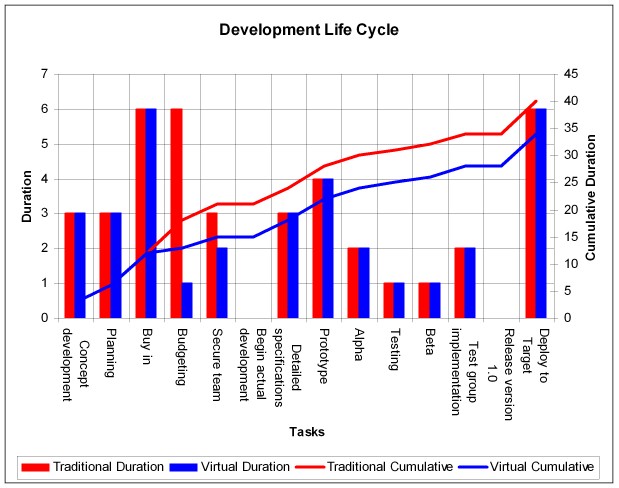Faster development cycles provide two clear benefits. First, shorter development cycles translate into lower costs. Second, earlier completion of revenue enhancing systems means longer periods of revenue capture. Compare the life cycles of a project in a traditional versus virtual corporation below. In this example, a typical software development cycle lasts 40 months in a traditional firm compared to 34 months in a virtual organization. That's a 10% savings in time. Also consider that in a traditional firm, the entire staff infrastructure is on the payroll through most of the cycle while in the virtual style, staff is only paid for work contracted and completed. | |

| |
|
Source: W.S.C. Inc.
Given the need to compete on platform to win business, serious attention to development is necessary to any organization's success and should be an integral part of their strategy. | |
|
A few weeks ago I attended the MIT CIO Symposium. Two topics dominating the agenda were cloud computing and social networking. Cloud computing was recognized by experienced CIOs as marketing terminology applied to the old mainframe practice of leasing computing time. Other participants saw it as a way to free their organizations from the difficulties of managing expensive and ever evolving hardware and network infrastructure. All agreed that cloud computing is here to stay and that CIOs need to pay special attention to vendor contracts in any outsourcing situation. In the end, the details of the contract control the risks and rewards of cloud computing.
|  |
|
As cloud computing and social networking become pervasive, the benefits apply to both fixed infrastructure and virtual organizations. Opportunities have never been better for firms to outsource much of their hardware. Software development projects are usually paired with capital expenses in the form of computer hardware. The costs of new or expanded servers, networks, and workstations must be factored into any development decision. Cloud computing makes it easier and less expensive to acquire the hardware for new platforms. Also, as existing hardware nears the end of its lifecycle, the decision can be made to outsource its functionality without sacrificing reliability. Choices on scale, reliability and cost are easier too. By carefully choosing service level agreements, costs can be reduced at the expense of guaranteed up-time that may be less critical in periods of low activity and then ramped up when usage returns. While it is painful to agree to lower levels of performance, having the flexibility to pay for different levels is a great option compared to the alternative of shutting down an initiative completely. Cloud computing allows the manager to change the scale and quality of their IT infrastructure more smoothly. | |
Continue: